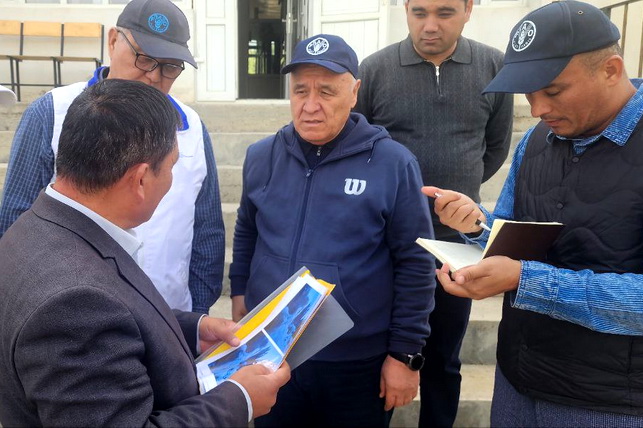
FAO delegation explores artificial glacier technologies in Kyrgyzstan to address water scarcity in Uzbekistan
FAO delegation explores artificial glacier technologies in Kyrgyzstan to address water scarcity in Uzbekistan
Tashkent, Uzbekistan (UzDaily.com) — A delegation from Uzbekistan, composed of representatives of the Food and Agriculture Organization of the United Nations (FAO), undertook a three-day study visit to Batken Region of the Kyrgyzstan. The mission was organized under the Food Systems, Land Use and Restoration Impact Program (FOLUR–Uzbekistan) project with the objective of studying innovative artificial glacier technologies as a solution to seasonal water shortages.
The delegation was introduced to the technology by Mr. Matraim Jusupov, FAO National Project Manager in Kyrgyzstan and an expert in water-saving technologies. During theoretical sessions and field visits, he explained the practical aspects of the system. On the first day, the delegation attended a presentation on the artificial glacier concept; on the second day, they visited pilot sites in the mountainous areas to observe the functioning of pipelines, vertical spraying pipes, and the water supply system. These structures, built with the labor and contributions of local communities, stood out for their sustainability and efficiency.
More than 90 percent of Uzbekistan’s agriculture depends on irrigation. In recent years, climate change, irregular precipitation, and the accelerated melting of natural glaciers have aggravated water scarcity. This is particularly evident in Karakalpakstan, Khorezm, and Kashkadarya regions, where water shortages have negatively affected agricultural production and rural livelihoods.
According to FAO experts, artificial glacier technology could become one of the promising solutions to strengthen climate resilience and improve water resource management in Uzbekistan.
The Batken experience demonstrated that local communities, by adopting simple, low-cost, and innovative technologies, can improve water supply and stabilize their livelihoods. It also created opportunities for direct community involvement in solving infrastructure challenges, especially through solutions adapted to local conditions. The introduction of gravity-based water delivery systems, rainwater harvesting facilities, and small-scale irrigation technologies helped reduce constant water demand, stabilize household incomes, and significantly ease the burden of water-related labor, particularly for women and youth. At the same time, ecological approaches to water use were reinforced, and awareness and responsibility for environmental protection among the population increased. These results fully align with the agroecological principles and integrated landscape management objectives of the FOLUR project. The Batken model is now being considered as a potentially replicable approach in similar climatic and social conditions in Uzbekistan.
Aziz Nurbekov, National Project Coordinator of FOLUR–Uzbekistan, emphasized:
“The FAO delegation’s learning on artificial glacier technology is not limited to Kyrgyz experience. We are also studying advanced approaches applied in India, Pakistan, and other countries. For example, in India’s Ladakh region, so-called ‘Ice Stupas’ are used to create sources of spring irrigation water for agriculture. In Pakistan, similar technologies allow communities to store river water in the form of ice and gradually use it during the vegetation season. These international experiences, together with practices in Kyrgyzstan, confirm the prospects of effectively applying artificial glaciers in Uzbekistan’s mountain areas, based on local traditions and community needs.”
At the conclusion of the mission, the delegation recommended to:
conduct feasibility and hydrological studies under Uzbekistan’s conditions;
organize training and study visits for specialists and farmers;
ensure community involvement through labor and co-financing;
integrate artificial glaciers with drip irrigation and pasture management;
introduce digital monitoring systems to measure water volumes and efficiency.
FAO Uzbekistan will continue cooperation with FAO Kyrgyzstan and other regional partners to expand knowledge and experience exchange on this innovative approach.